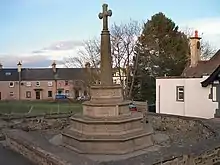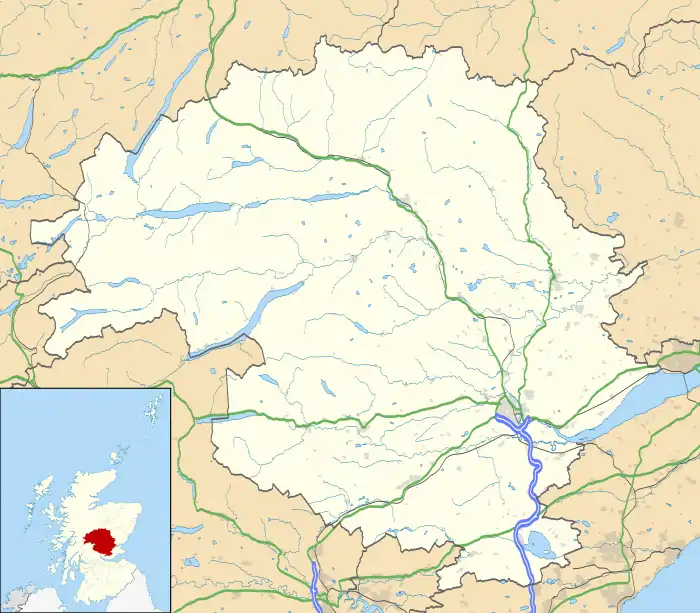Luncarty
Luncarty (![]() listen ; pronounced Lung-cur-tay) [ˈlʌŋkəɾte]) is a village in Perth and Kinross, Scotland, approximately 4 miles (6 kilometres) north of Perth. It lies between the A9 to the west, and the River Tay to the east.
listen ; pronounced Lung-cur-tay) [ˈlʌŋkəɾte]) is a village in Perth and Kinross, Scotland, approximately 4 miles (6 kilometres) north of Perth. It lies between the A9 to the west, and the River Tay to the east.
Etymology
The name Luncarty, recorded in 1250 as Lumphortyn, may be of Gaelic origin.[1] The name may involve the element longartaibh, a plural form of longphort meaning variously "harbour, palace, encampment".[1]
History

The historian Hector Boece (1465–1536), in his History of the Scottish People, records that, in 990, Kenneth III of Scotland defeated the Danes near Luncarty.[2] However, the Scottish historian John Hill Burton strongly suspected the battle of Luncarty to be an invention of Hector Boece.[3][4] Burton was incorrect. Walter Bower,[5] writing in his Scotichronicon around 1440, some 87 years before Boece first published his Scotorum Historia, refers to the battle briefly as follows:
- "that remarkable battle of Luncarty, in which the Norsemen with their king were totally destroyed". Bower does not quote specific sources concerning the battle, but, two sentences later, he refers in a general way to ancient writings that he has consulted. The term Norsemen would include Danes.
The present village was founded in 1752 by William Sandeman, to house workers at his bleachfields.[6] The village formerly had a railway station,[7] and the Perth to Inverness railway line still runs through the village.
A rare example of a morthouse is located in the churchyard, built to frustrate the activities of bodysnatchers in the 19th century.
Bleachfields
William Sandeman and his partner Hector Turnbull manufactured linen in Perth and bleached it in Luncarty, for instance with an order of 12,000 to 15,000 yards (11,000 to 14,000 metres) of "Soldiers' shirting". In 1752 he leveled 12 acres (5 hectares) of land in Luncarty to form bleachfields. By 1790 when William died, the Luncarty bleachfields covered 80 acres (32 hectares) and processed 500,000 yards (460,000 metres) of cloth annually. Second only to agriculture, linen manufacture was a major Scottish industry in the late 18th century — linen then became less important with the introduction of cotton.[8]
Sport
The village is home to the football club Luncarty F.C., who play in the East of Scotland League First Division Conference B.
Notable persons
- Christopher Bowes, musician
- Jimmy Guthrie, footballer
- Jim Patterson, footballer
- George Turnbull, civil engineer
References
- Watson, W.J.; Taylor, Simon (2011). The Celtic Place-Names of Scotland (reprint ed.). Birlinn LTD. ISBN 9781906566357.
- Groome, Francis H. (1882–1885). "Luncarty". Ordnance Gazetteer of Scotland: A Survey of Scottish Topography, Statistical, Biographical and Historical. Gazetteer for Scotland. Retrieved 9 July 2008.
- The History of Scotland from Agricola's Invasion to the Revolution of 1688,Vol.1, By John Hill Burton; p.364-365, Will. Blackwood and Sons, 1867
- A Complete Guide to Heraldry; p.415; By Arthur Charles Fox Davies, and Graham Johnston; Published by Kessinger Publishing, 2004; ISBN 1-4179-0630-8, ISBN 978-1-4179-0630-7; link
- S Taylor, DER Watt, B Scott, eds (1990). Scotichronicon by Walter Bower in Latin and English.Vol.5. Aberdeen: Aberdeen University Press. pp. 341–343.CS1 maint: multiple names: authors list (link) CS1 maint: extra text: authors list (link)
- "Luncarty". Gazetteer for Scotland. Retrieved 9 July 2008.
- "Luncarty, Station". canmore.org.uk. Retrieved 19 July 2017.
- Perth Entrepreneurs: the Sandemans of Springfield by Charles D Waterston, 2008, pages 27–33: these pages reference 19 other information sources. ISBN 978-0-905452-52-4
